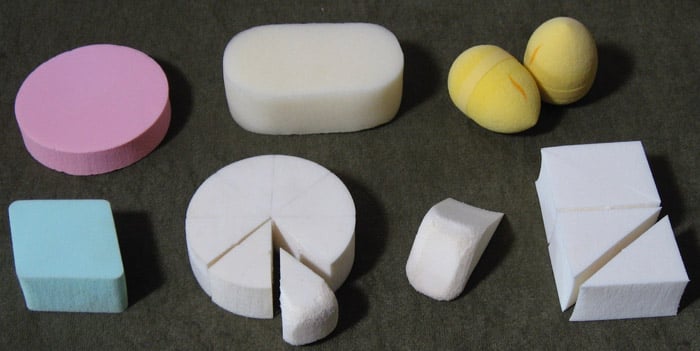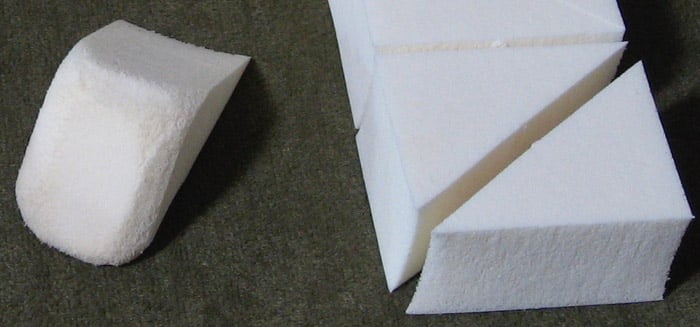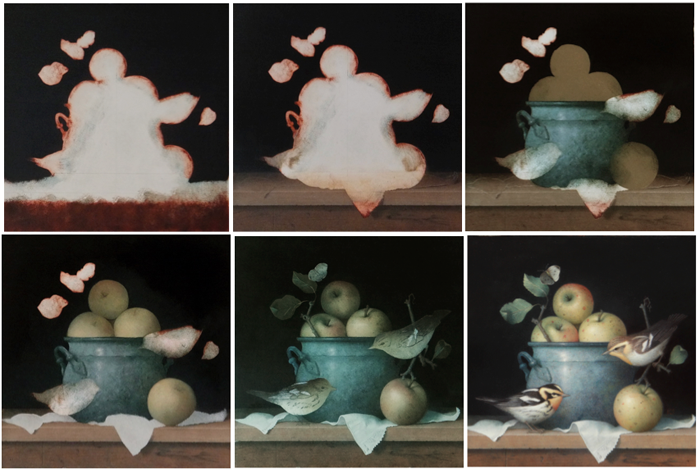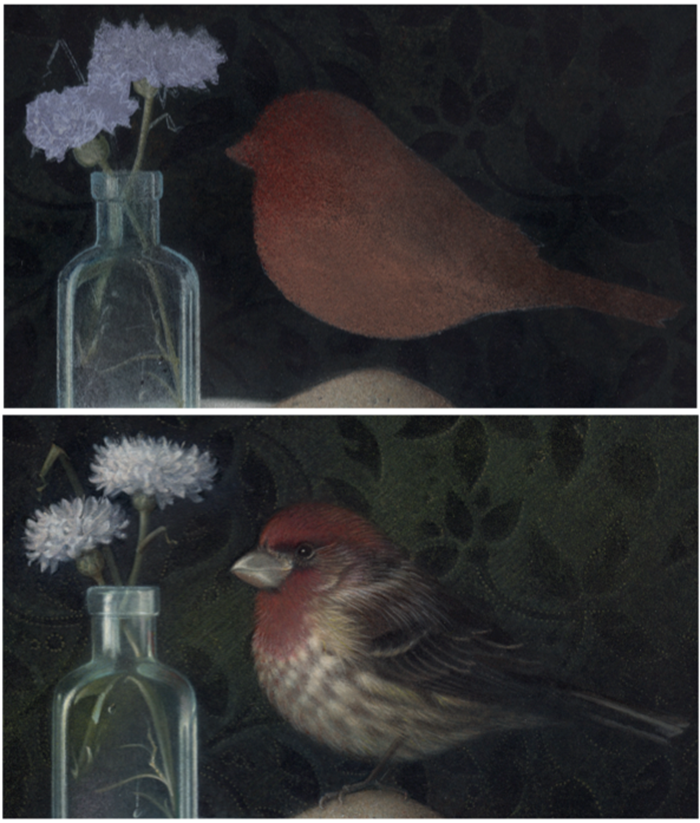
My transitions aren’t flawlessly smooth but rather a weave of many layers of different marks made by both brushes (of various sizes) and sponges.
By Koo Schadler
It’s impossible to physically blend egg tempera paint once it’s been applied because reworking fresh paint dissolves and lifts underlying layers. Thus whatever tool is used to apply egg tempera leaves behind its mark: A brushstroke stays a brushstroke visibly, sponged on paint, and carries the imprint of the sponge. This “mark making” tendency means egg tempera is ideal for rendering fine details, crisp textural effects, and other linear elements. The challenge in tempera is to create smooth, mark-free transitions.
Most tempera artists embrace the medium’s linearity and use crosshatched lines to render the form. Crosshatching is beautiful and practical, yet it suits neither my temperament nor aesthetic. I aspire to smooth transitions. Over the years, I’ve developed an unconventional method that achieves nearly mark-free transitions in tempera. Even when I demonstrate in person, it’s hard to quickly put this method into practice because it is multi-faceted, subtle, and slow.[1] A verbal description is limited, but nonetheless, here is an explanation of how I minimize marks to create smooth transitions.
Step 1. Use Cosmetic Sponges
Tempera artists commonly use kitchen and sea sponges to create textured paint applications. It’s also possible to paint with texture-free sponges. Cosmetic sponges are smooth. They come in different shapes and sizes with varying degrees of density and absorbency. Everyone seems to develop a personal favorite, so I encourage you to experiment instead of recommending a specific brand. Be wary of inexpensive make-up sponges from a chain drug store. They’re generally soft and squishy and collapse under pressure. Sponges from high-end cosmetic companies tend to work better; the material is dense and more resistant, like a brush with good spring or snap.

Different cosmetic sponges.

My preferred sponge is wedge-shaped. I like the way it holds paint, and I can use the long end as a sort of handle. Wedge sponges have hard edges that can leave marks, so on the side of the sponge used to apply the paint, I trim the edges with sharp scissors (see an example of a trimmed sponge, also at right). Rounded edges help create more mark-free, amorphous layers of paint.
In most subjects that I paint, I begin by defining with a base coat of sponged on paint. The term “base coat” will be explained in Step 2, but first, a bit more about sponging.
First, wet a sponge, then squeeze it nearly dry before loading it with paint. A sponge may seem like a simple tool, but using it well takes practice. Several considerations must be understood and mastered, including:
-
The quality of paint to use. Depending on the job at hand, I use dense and very watered-down paints.
-
Amount of paint loaded onto the sponge. Too little paint on the sponge won’t leave a consistent mark, but an overloaded sponge can puddle and make a mess. You need just the right amount.
-
How to hold the sponge to control it (see photo below).
-
How hard to press? People often don’t press down hard enough, leaving behind an inconsistent mark; if you press too hard, the paint squishes out and puddles. You need just the right touch.
-
How to slightly overlap paint layers and feather out edges, so you don’t leave a hard edge. Overlapping and feathering sponged-on marks allow layers to gradually, optically blend together.

Painting a sky with a cosmetic sponge. I mixed four values of sky color (below). Each value was applied with a different sponge. I started with relatively thick paint (about the texture of light cream), but as the sky developed, I transitioned to thinner and thinner paint (akin to skim milk). By the final 20 layers, I was working with very watered-down paint (more like water than milk), as described in Step 3. Occasionally, when the panting seemed to call for it, I applied a scumble or glaze (described in Step 4) over the entire surface to unify and enrich the image. An evenly gradated the atmospheric sky may entail up to 50 or more paint layers to achieve a consistent transition. If that number seems daunting, keep in mind that thin paint layers dry quickly, and I can paint a 5 x 7” smoothly transitioned sky in an hour or so.

If sponging doesn’t produce good results at first, but you sense it’s useful, don’t give up. Experiment, pay attention, and practice; give yourself a chance to get good at it. With experience, you learn the right amount of paint and the correct touch. Wash sponges well with soap after use; they last for months with good care.
Step 2. Begin By Laying Down a “Base Coat”
As described in Step 3, one of the keys to mark-free transitions is to use fragile, watered-down paint. It’s possible to work exclusively with thinned paint and eventually render a form, but accumulating enough layers of such inconsequential paint is very slow, especially in large areas. To expedite the process, I first apply a “base coat”—a layer of thicker, more covering paint.[2]
Base coat paint is dense, akin to light cream; it’s essentially pigment paste properly tempered with yolk medium, little to no added water (beyond what is already in pigment paste and medium). The base coat color approximates the local color and value of the rendered form (although sometimes I may do a complementary color underneath). It is opaque (a pinch or more white in the mix) and covering. It’s similar to how oil painters block in the subject matter.

The first image shows the figure blocked in with base coats. On the far right is the completed portrait. The landscape was painted first, more or less completely, then the figure was painted in front.
I use cosmetic sponges to apply base coats because sponges work well for broad, consistent paint applications. Learning how to do so—without making unwanted marks, lifting paint, or creating too much texture—takes time and attentive practice. If, at first, you don’t succeed, try again. Working with sponges and base coats doesn’t suit every temperament, but if you want to speed up a tempera painting, these are effective ways to do so.

Left: With the background mostly complete, I sponged on base coats. I used a mask to protect the background while I sponged on blue paint for the bowl and pale green paint for the acorns, leaves, and apples. Masking is explained in step #5. Right: The completed painting.
Once a base coat is established, I paint on top with brushes to render form and details very gradually. I work primarily with very thin paint.
Step 3. Use Very Watery, Thinned Paint
One of the keys to creating smooth transitions in tempera is to render a form with very thin paint. Once the paint is tempered correctly (has the correct ratio of pigment to yolk), it can be thinned considerably with water. Watered-down paint leaves a faint, less distinct brushstroke. It’s the difference between:
THIS sort of mark versus THIS sort of mark.
A faint mark does not create a significant change in color or value; consequently, a faint mark has less sharply defined contours. If enough visually minor marks, with indistinct contours, are painted atop the other, they eventually add up and render the form. However, very faint brushstrokes are so inconsequential that A LOT of them must be applied to add up to something. Those two things can be challenging for people to grasp: (1) The degree to which paint must be thinned with water so that it doesn’t leave behind too much of a mark (people generally do not thin their paint enough and make too distinct a brushstroke); and (2) How many layers of very faint paint must be applied to create a form (people tend to stop before they’ve put on enough layers).
 The underlying brushstrokes have soft, diffused edges because they were made with watered-down paint. They do not read as individual, linear brush marks—except for the two green strokes on top. The green paint wasn’t thinned enough, and thus each green stroke appears as a distinct, hard-edged line. The two green lines interrupt the otherwise seamless, sfumato-like accumulation of paint layers underneath.
The underlying brushstrokes have soft, diffused edges because they were made with watered-down paint. They do not read as individual, linear brush marks—except for the two green strokes on top. The green paint wasn’t thinned enough, and thus each green stroke appears as a distinct, hard-edged line. The two green lines interrupt the otherwise seamless, sfumato-like accumulation of paint layers underneath.
Bear in mind this simple but critical fact: if you thin paint with water, apply a brushstroke, and it leaves too much of a mark (THIS but not THIS), then you are leaving too much of a mark. Do not judge if the paint is sufficiently thinned by how much water you’ve added or how it looks on your palette; believe the evidence of the brushstrokes on the panel. If the paint creates too strong a mark—a distinct line that interrupts a smooth transition—the paint has not been thinned enough. Add more water and try again. I build up many dozens of layers of this very watered-down paint. Ever so gradually, the layers add up to an image woven from scores of faint brush marks. Watching form emerge this way is like looking into a room as a dimmer switch slowly turns and gradually reveals objects within. There are considerations to working with such watery paint, including:
1. In a very watery paint, the elements (pigment, water, egg) tend to separate as they sit on a palette or in a well. To ensure they stay blended, I use the tip to first swirl and recombine elements before loading the brush with watered-down paint each time I load my brush.
2. Very watery paint may require a touch more yolk to ensure enough binder is dispersed throughout. Be wary of adding too much binder—that’s not good either. With attentive practice and experience, you learn when to add a bit more yolk and how much.

3. It is critical to wipe your brush every time you load it. I press the tip between my fingers and a rag to remove excess paint.[3] You want enough paint left behind in the brush to lay down a smooth-flowing mark but not so much paint that you create puddles. It’s akin to working dry brush, yet the strokes don’t “chatter” or skip; the paint flows smoothly yet controlled manner.
4. I use a #0 to #8 round brush (depending on the size of the area I’m working on). Regardless of brush size, as I wipe the brush, I also shape and flatten its end so that it lays down a broader stroke.
5. It’s essential to lift the brush at the end of each stroke; otherwise, a dot of paint remains at the end. As you apply the brush, think of it taking off like an airplane at the end of each stroke.
Many layers of very watered-down, thinned paint (applied atop a thicker sponged base coat to speed things along) are essential to creating smooth transitions. Glazes and scumbles are also important.
Step 4. Apply Glazes and Scumbles
A glaze is a thin layer of transparent color, like a sheet of cellophane or stained glass, applied over parts or all of a painting. Naturally, transparent pigments work best, but nearly any color, if applied very dispersed in a thin layer, can be made to appear transparent and behave like a glaze.
A scumble is opaque white paint applied in such a thin, dispersed layer that it appears semi-transparent; it’s like a mist or veil of gossamer laid over parts or all of a painting. Scumbles may be pure white or white tinted with a bit of color.
A glaze or scumble applied smoothly and evenly acts as a unifying layer over the surface of a painting (either in part or the whole) and thus minimizes brush strokes. The key is to apply them consistently, with minimal marks.
To make a glaze or scumble, start with tempered paint (color for a glaze, white for a scumble) and add water until the paint can be applied thinly enough to see through to underlying layers.[4] Use a brush (any size, depending on the covered area) or a sponge for application. I find it easiest to get an even layer using a cosmetic sponge. Remember that laying down mark-free, consistent glazes and scumbles takes practice.
I apply glazes and scumbles throughout the development of a painting, even as an image nears completion; they comprise a significant portion of my paintings and are critical to my process; in addition to visually unifying a surface, glazes and scumbles create other effects (from modified values, chroma, and temperature to increased luminosity). A list of their characteristics is given in the glaze and scumble appendix. Become familiar with the effects of glazes and scumbles, and you’ll gradually understand when a painting calls for one or the other.

GLAZE. Over a base of sky color (first column), I applied glazes of six transparent hues: viridian green, alizarin, Prussian blue, burnt sienna, and transparent yellow ocher.

SCUMBLE. The faint, misty, transparent layer of white on the left side is a scumble. The opaque swatch of white on the right is not a scumble (more a snowstorm!)


The landscape before scumble (left). Landscape after scumble (right). The scumble has unified the surface, imparted opacity (creating an excellent base to glaze upon), and suggested atmospheric perspective. It also lightened some dark values more than I wanted, so next, I’ll go back to working with thinned paint to reestablish darks, turn form and render details. At some point, I’ll scumble once more and start the process all over again. It’s not uncommon in tempera to paint something, partially lose it, then repaint it; a sort of zigzag journey towards the final image, all part of building up innumerable layers.
Step 5. Use Masks
A pointed brush is an “intentional” tool—like a pencil, you can place its marks precisely where you want them to go. A sponge is a more amorphous, “unintentional” tool. Its marks tend to go outside the contour of a form. For this reason, whenever I use a sponge (either to apply base coats or glazes and scumbles), I always protect the surrounding areas of the painting (wherever I don’t want the paint to go) with a mask.
To make a mask, lay acetate (also known as wet media film) over an image, trace the outlines of the object to be painted, then cut out the shape. Paint tends to travel around the cut edges of acetate and leak onto underlying areas you’re trying to protect, so opt for thinner media films (.001” to .002”). Another option is to make photocopies of a drawing and cut out masks from the copies. I like the thinness and slight absorbency of copy paper (paint is less likely to travel around its edges), and despite being paper, it works pretty well to protect surrounding areas from wet paint (however, an overloaded sponge can create puddles that soak and ruin paper). If paper masks become too wet and curl at the edges, try coating them (before use) with acrylic gel medium or frisket paper. These are just a few things to consider when masking. As with the other steps in my process, if masking suits you and helps you achieve your goals, you’ll become proficient with practice.

Image 1. Most of the painting—background, ledge, etc.—has been developed, except for the bird. I’ve carefully sanded down to white gesso in the area where he’ll be painted. 2. I cut out the bird’s shape on a copy of my original drawing. I put this mask over where the bird is in the painting. Holding the mask in place, I sponged on several base coats of thick paint to render the values and color of the bird. 3. Next, I used white transfer paper to lay in the bird’s features atop the sponged base coat. 4. At this stage, I worked with thinner paint to begin modeling the bird’s form and defining its features. 5. Many layers later (including occasional scumbles and glazes, applied using a sponge with a mask), the painting is complete—more examples of paintings in various stages of development and the completed image.
Step 6. Sand and Polish
The final piece of my working method is to occasionally sand and polish the surface. I do so perhaps every 10 or 20 layers (or whenever the painting seems to call for it). Light sanding or gentle polishing smoothes the surface and helps with transitions. Be very attentive when working the surface. You are merely trying to minimize textural irregularities—not rub, scratch, or remove paint. I use extra fine, “micro” grit (1500 to 2000) sanding sponges for sanding. They are thin and flexible and work well for delicate and controlled sanding. For polishing, I use fine cheesecloth.

Conclusion
It took many years to develop my working method. It arose gradually, through much experimentation, and organically, out of my nature. Because it fits my temperament (akin to a craftsman) and facilitates my goal of smooth transitions, it is ideally suited to me. I don’t presume it for anyone else. If parts of the process support or simplify your painting, don’t be deterred by a nontraditional approach; after all, the history of painting is one of the inventions. If you initially don’t achieve good results, continue to experiment—painting well requires inspiration and attentive, diligent effort. Days turn into weeks, and weeks become years of working with egg tempera. Eventually, you become familiar with your and the medium’s strengths and weaknesses, quirks, and possibilities, and a working method ideally suited to you reveals itself.
More examples of paintings in various stages of development and the completed image:

1. Carolina Rosa, approx. 12" x 9"

2. Girl in Profile—Ellie, detail, 9 ¾” x 7 ½.”

3. Girl with Lock and Key, 11 ¾” x 8 ½.”

4. Apples and Blackburnian Warblers, 10 ¾” x 10 ¾.”

5. Odessa, 9 ½" x 7 ¾"

6. Purple Finch and Bachelor Buttons, detail, 9 ¾” x 8 ½.”

7. Portrait of Lily with Zinnia, 10 ½” x 7 3/8”
Notes
1. The long explanation that follows may make my method seem impossibly difficult and slow. I want to assure readers that with enough practice, the various steps I describe become increasingly sensible, easy, efficient—even rewarding and fun if they suit your nature and goals.
2. The only times I do not apply a “base coat” is when I paint small objects, anything about an inch or less in size. Painting in tempera is a matter of “things” and “inches”; i.e., the more objects within a composition and the larger the overall image, the longer it takes to apply enough layers to make forms emerge and for the painting to take shape. Very small objects can be rendered with a brush reasonably quickly, but bigger subjects, if rendered using only brushstrokes, can take a long time to develop. This is why I devised a “short cut” of first applying base coats of thicker paint, then working with many layers of thin paint (as described in the next step) on top. Developing form in tempera can require dozens of paint layers; sponging on a base coat gets you there more quickly.
3. I like to feel the brush as I shape it, but some painters prefer to place a wiping rag on the table in front of them, so their skin doesn’t come in contact with the paint. If you’re going to be exposed to paint, consider wearing gloves or barrier cream, especially if working with toxic colors.
4. Do not add more egg to thin paint to a glaze or scumble consistency. Once you have your paints properly tempered (correct ratio of egg to pigment), use only water to further thin the paint. Adding egg does not increase the transparency or luminosity of a scumble or glaze; it merely adds excess binder to the paint film, which can create cracking and other problems.
© 2017 Koo Schadler
About Koo Schadler
Koo Schadler’s egg tempera paintings and silverpoint drawings are in more than 400 private, corporate, and museum collections worldwide, including the Fine Arts Museum of San Francisco and the Philadelphia Athenaeum. She is a popular workshop instructor who has taught around the US and abroad for more than 20 years. Schadler is a master painter of the Copley Society and a contributing editor to The Artists’ Magazine. Her work is represented by the J. Cacciola Gallery in New York and Arden Gallery in Boston, MA. Her comprehensive book on egg tempera has been described as “one of the most concise and useful books on the art of egg tempera painting…should be on the bookshelf of every serious artist”.
Visit Koo Schader” s website for more techniques and information about egg tempera painting: www.kooschadler.com.
 Egg Tempera Painting by Koo Schadler
Egg Tempera Painting by Koo Schadler
A comprehensive guide to painting egg tempera for the beginning and advanced egg tempera artist. Self-published by the author; black and white, spiral bound, 170 pages. The book includes the following:
- A detailed description of how to make true gesso panels from scratch
- A variety of ways in which to work in egg tempera—using brushes, sponges, glazing, scumbling, and more
- A description of painting a portrait in egg tempera
- An updated and expanded chapter on how to finish an egg tempera painting, including oil painting over tempera and varnishing
- Many appendices, including six new ones added in 2015
To purchase the book, please visit Koo Schadler’s page.
Koo Schadler Workshops
Old as the Egyptians and most famous during the Renaissance, egg tempera painting is becoming increasingly popular with artists today. Tempera has unsurpassed luminosity. Though dozens of glazes and scumbles can be applied in a day, the medium also allows for meticulous linear detailing. In Koo’s comprehensive workshops, students learn about all aspects of the medium: egg tempera’s rich history, traditional gesso panels and powdered pigments, traditional and contemporary working methods, oil glazing over tempera, and much more. All workshops are open to all levels of painters, from beginner to advanced.
Workshop Schedule
To see the latest schedule of workshops visit:
www.kooschadler.com/workshops.htm


 Egg Tempera Painting by Koo Schadler
Egg Tempera Painting by Koo Schadler









